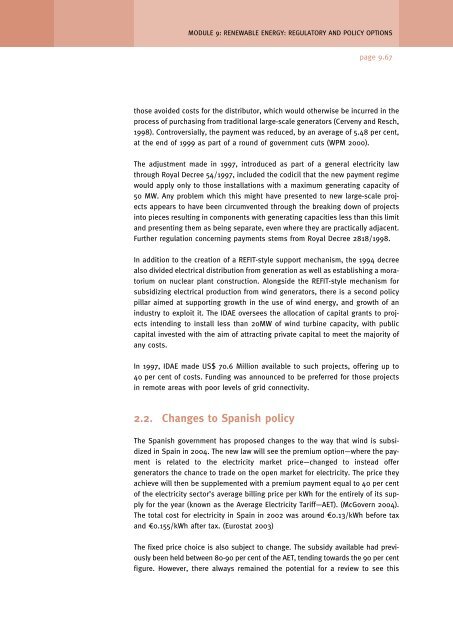Regulatory and policy options to encourage development of ...
Regulatory and policy options to encourage development of ...
Regulatory and policy options to encourage development of ...
- No tags were found...
Create successful ePaper yourself
Turn your PDF publications into a flip-book with our unique Google optimized e-Paper software.
MODULE 9: RENEWABLE ENERGY: REGULATORY AND POLICY OPTIONSpage 9.67those avoided costs for the distribu<strong>to</strong>r, which would otherwise be incurred in theprocess <strong>of</strong> purchasing from traditional large-scale genera<strong>to</strong>rs (Cerveny <strong>and</strong> Resch,1998). Controversially, the payment was reduced, by an average <strong>of</strong> 5.48 per cent,at the end <strong>of</strong> 1999 as part <strong>of</strong> a round <strong>of</strong> government cuts (WPM 2000).The adjustment made in 1997, introduced as part <strong>of</strong> a general electricity lawthrough Royal Decree 54/1997, included the codicil that the new payment regimewould apply only <strong>to</strong> those installations with a maximum generating capacity <strong>of</strong>50 MW. Any problem which this might have presented <strong>to</strong> new large-scale projectsappears <strong>to</strong> have been circumvented through the breaking down <strong>of</strong> projectsin<strong>to</strong> pieces resulting in components with generating capacities less than this limit<strong>and</strong> presenting them as being separate, even where they are practically adjacent.Further regulation concerning payments stems from Royal Decree 2818/1998.In addition <strong>to</strong> the creation <strong>of</strong> a REFIT-style support mechanism, the 1994 decreealso divided electrical distribution from generation as well as establishing a mora<strong>to</strong>riumon nuclear plant construction. Alongside the REFIT-style mechanism forsubsidizing electrical production from wind genera<strong>to</strong>rs, there is a second <strong>policy</strong>pillar aimed at supporting growth in the use <strong>of</strong> wind energy, <strong>and</strong> growth <strong>of</strong> anindustry <strong>to</strong> exploit it. The IDAE oversees the allocation <strong>of</strong> capital grants <strong>to</strong> projectsintending <strong>to</strong> install less than 20MW <strong>of</strong> wind turbine capacity, with publiccapital invested with the aim <strong>of</strong> attracting private capital <strong>to</strong> meet the majority <strong>of</strong>any costs.In 1997, IDAE made US$ 70.6 Million available <strong>to</strong> such projects, <strong>of</strong>fering up <strong>to</strong>40 per cent <strong>of</strong> costs. Funding was announced <strong>to</strong> be preferred for those projectsin remote areas with poor levels <strong>of</strong> grid connectivity.2.2. Changes <strong>to</strong> Spanish <strong>policy</strong>The Spanish government has proposed changes <strong>to</strong> the way that wind is subsidizedin Spain in 2004. The new law will see the premium option—where the paymentis related <strong>to</strong> the electricity market price—changed <strong>to</strong> instead <strong>of</strong>fergenera<strong>to</strong>rs the chance <strong>to</strong> trade on the open market for electricity. The price theyachieve will then be supplemented with a premium payment equal <strong>to</strong> 40 per cen<strong>to</strong>f the electricity sec<strong>to</strong>r’s average billing price per kWh for the entirely <strong>of</strong> its supplyfor the year (known as the Average Electricity Tariff—AET). (McGovern 2004).The <strong>to</strong>tal cost for electricity in Spain in 2002 was around €0.13/kWh before tax<strong>and</strong> €0.155/kWh after tax. (Eurostat 2003)The fixed price choice is also subject <strong>to</strong> change. The subsidy available had previouslybeen held between 80-90 per cent <strong>of</strong> the AET, tending <strong>to</strong>wards the 90 per centfigure. However, there always remained the potential for a review <strong>to</strong> see this










